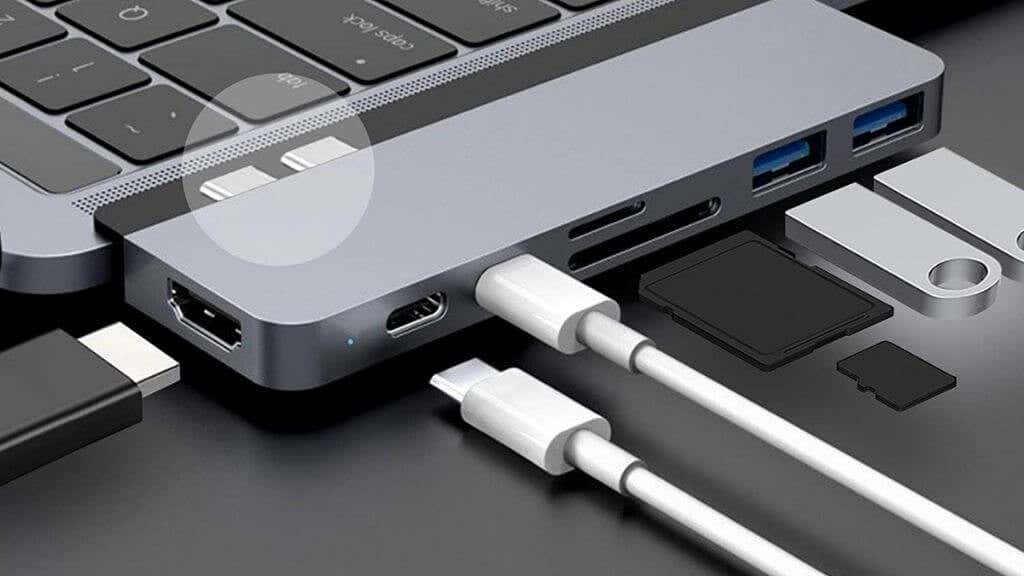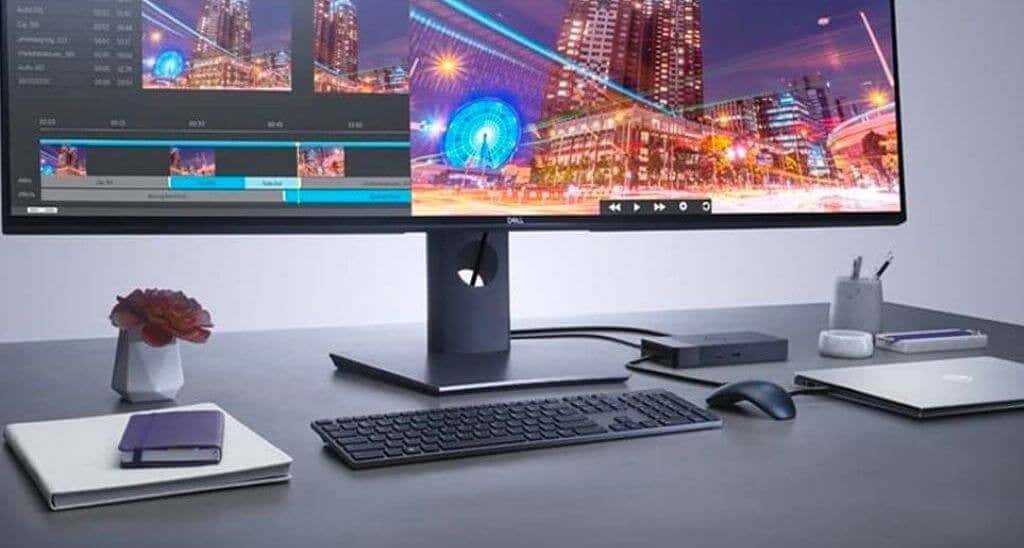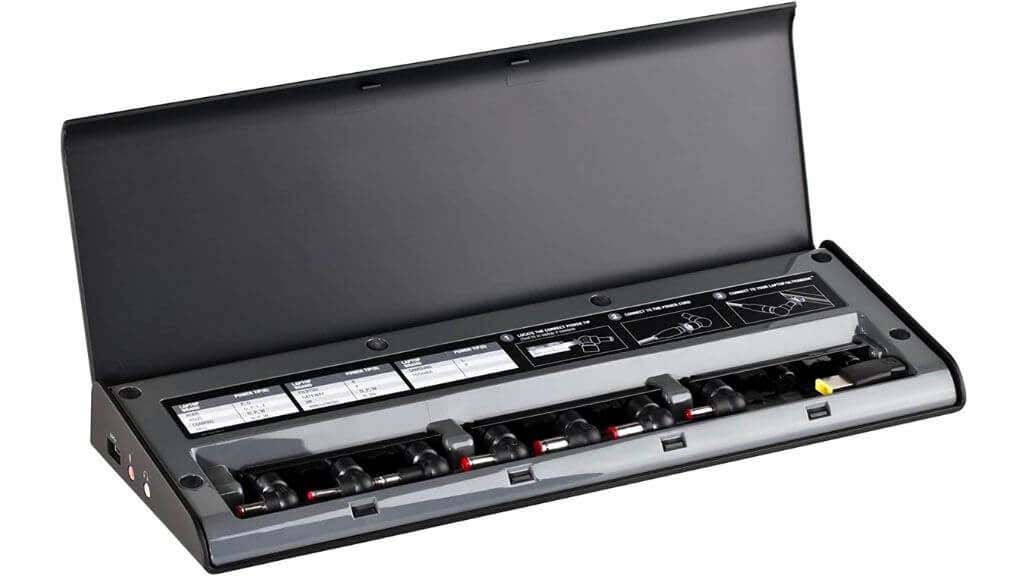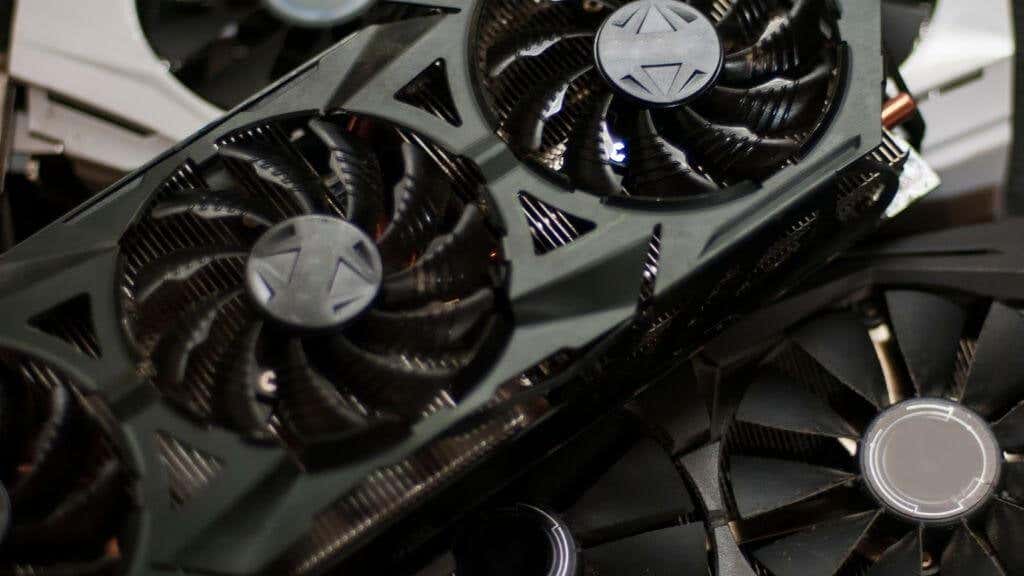Laptop docking stations offer a convenient way to convert your laptop from a portable system to something more like a desktop. After all, even the best laptop can’t include every port you need!
Docking stations let you create an efficient workspace; they let you connect full-size keyboards, mice, speakers, and even a 4K monitor that wouldn’t be possible in a portable system.
The world of docking stations has become more diverse than ever. Many significantly different devices are called “docking stations,” but we’ll clear up the confusion in no time.
Port Replicator vs. Docking Station
There’s a minor issue with terminology regarding docking stations for laptops. In the past, “docking station” specifically meant the proprietary docking station for a specific brand and model range. These stations offered a variety of ports and power for the laptop.
On the other hand, a port replicator was a device that provided the same ports the laptop already had, but you could leave it at home already plugged in for a speedy switch to desktop mode. This is different from a USB hub, which gives you more USB ports.
Today the two terms are interchangeable, and “port replicator” has fallen into disuse. Thanks to the rise of USB-C and Thunderbolt (which we’ll cover below), the need for proprietary connections isn’t all that strong anymore. This article will use the term “docking station” as an umbrella term to cover port replicators and dongles.
There’s also a device known as a “multiport adapter.” Still, these are generally much less feature-packed than docking stations, with perhaps two or three essential ports but not enough to connect a complete set of peripherals.
Portable vs. Desktop Laptop Docks
The primary purpose of a docking station is to let you attach a monitor, keyboard, mouse, and speakers to your laptop quickly and conveniently. If you have a permanent desk setup, you’d leave your dock behind, plug in all your peripherals, and connect your laptop to it when you sit down.
However, USB-C docks are so compact that you can fit them in the little pouch you get on most laptop sleeves. This allows you to connect your laptop to peripherals wherever you go, adding a new type of portability to docking stations. This is only relevant to the new generation of ultra-thin ultrabooks that lack the correct ports.
Proprietary Laptop Docks
While it’s rare these days, some laptops still offer the option of a proprietary dock. This is a dock that connects to the laptop using a proprietary connector. The main advantage of these docs is that they offer high-performance expansion and enjoy hardware-level support. In other words, they’d work perfectly since they are designed as an extension of the laptop by the manufacturer. Although some features may still depend on drivers in your operating system, which are usually only guaranteed for Microsoft Windows.
Despite new connection standards, this is not always the case for third-party docks. For example, we have a dock that refuses to fully work with an M1 MacBook Air, every port except for the speaker output works. Another dock we’ve worked with has an unreliable HDMI video output, so there is a market left for rock-solid proprietary solutions.
The Dell E-Port docking station is designed specifically for Dell E-series laptops. It uses a special connector that plugs into the bottom of the computer through a door. The station is designed to stay on your desk and has its power supply brick. Simply pop your laptop on it and press a release button when you need to leave.
USB-C and Thunderbolt connection technologies have reduced the need for docking stations like these. Still, if your particular laptop does happen to support an in-house docking solution, it’s worth considering in case it offers any unique technological or ergonomic benefits.
USB Type C or Thunderbolt 3 Docks?
Today, there are two major connection standards for docks: USB-C docking stations and Thunderbolt 3 docking stations.
What might be a little confusing is that both of these connection standards use the same USB-C connector. USB and Thunderbolt are two different communication protocols, but they have significant levels of cross-compatibility.
You can check out our in-depth guides for more details on the fine details, but here’s the short and sweet version.
Thunderbolt 3 is backward compatible with USB 3. So any USB-C device that uses USB will work when you plug it into a Thunderbolt 3 port. The same is not true when you want to use a Thunderbolt-only device with a USB port. Most devices support both Thunderbolt 3 and USB 3.0, but if you use a Thunderbolt 3 device, you need a Thunderbolt 3 port and cable.
If you’re using a USB dock, you’re still limited to the USB performance, even if it’s plugged into a Thunderbolt dock!
Typical Ports on Docking Stations
Docking stations offer a variety of ports, some of which are already on your laptop and some of which are an expansion of what you have on the base system. In general, you’ll find display connectors such as HDMI or DisplayPort. Some docks may still have legacy connectors for VGA and DVI monitors, especially in large businesses where older displays are still in circulation.
Many modern laptops, especially ultrabooks, don’t have Ethernet ports since the port would be too thick for the laptop. It’s common to find an Ethernet port on docking stations, and if you’re leaving the station on your desk rather than taking it with you, it makes sense to leave it hooked up to a fast wired connection.
USB ports are universally present on docking stations, but the exact number and type vary. USB type-A is guaranteed, but you may even get extra USB-C ports.
Most docking stations also have a 3.5mm speaker jack, although the audio is output over the HDMI or DisplayPort ports.
You may also find SD card readers on some docks, which is a priced feature these days, given that many slim laptops have also dropped SD card readers from their built-in ports.
Docking Station Display Support
One of the great things about docking stations is that they allow you to connect one or more external displays. That’s in addition to the built-in display on your laptop. So by adding a single monitor through the docking station, you instantly have a dual-monitor solution.
If that’s not enough, some docking stations offer multiple display outputs. So you can have two or more monitors connected to the docking station, allowing for triple-monitor or even larger setups.
This sounds great, but it’s essential to pay special attention to exactly how many monitors a dock supports, what resolution is supported, and what refresh rates they can run at.
For example, we recently tried to use the 4K HDMI port on a dock with an M1 MacBook Pro. Sadly that dock supports a maximum of 30hz at 4K resolution instead of 4k 60hz. To get a 4K external monitor working at 60Hz, we used an adapter that supports DisplayPort over USB-C.
Universal Docking Stations
You may have come across a docking station known as a “universal” docking station. This is a special type of docking station designed for multiple laptops. It’s most useful for “hot desking,” where different people sit at a shared desk at other times, but it also makes sense if you switch between different laptops.
What sets universal docking stations apart from other types is supporting different power connector standards. Take the Targus Universal Docking Station (pictured above) as an example. Inside the station, you’ll find numerous types of barrel plug connectors. This allows the station to work with virtually any laptop, as long as it falls within the power supply limits. In this specific case, that limit is 90W.
We’ve seen regular USB-C or Thunderbolt docks referred to as “universal” docking stations, which makes sense compared to proprietary docking stations. However, given that these docking stations are becoming the standard, it doesn’t make much sense to refer to them in this way.
External GPU Docks
One interesting type of docking station adds much more than a few more ports to your laptop. External GPU docking stations use Thunderbolt 3 (and soon Thunderbolt 4) to connect your laptop to a high-powered external GPU.
This can be an embedded GPU like the Sonnet eGPU Breakaway Puck or an enclosure where you can install whatever GPU card you want. At least within the power and physical size limits of a given enclosure.
You’ll notice that those GPU docks also have USB ports, power connections, and other connectors you’d find on a standard dock. You take your slimline laptop with you during the day for routine work or study applications. Simply plug in your laptop and take advantage of the powerful external GPU when you get home. Whether this is a good idea in practice depends, but you can check out our external GPU explainer to figure out if this is a solution for you.
One important thing to note is that your laptop must explicitly have eGPU support. Not all computers with Thunderbolt 3 or 4 will work with an eGPU. For example, Intel-based Macs with Thunderbolt 3 support eGPUs, but M1 Apple Silicon Macs don’t!
Laptop Docking Stations and Power
As we’ve seen, docking stations can power your laptop or, in some cases, receive power from your laptop if you take them on the road, but it’s worth going over the exact power situation since it can be a little confusing.
First of all, most low-power laptops these days can charge from USB-C. They’ll charge from phone chargers, for example. However, you need high-wattage power sources to get the fastest charge or prevent the laptop from draining its battery during use.
USB-C PD (Power Delivery) is a USB-C standard that allows more than 100W of power to be delivered over a USB PD cable. Most USB-C docks have a power pass-through, so you only need one port on the laptop to use the dock and charge up simultaneously.
Larger laptops, especially power-hungry systems with discrete GPUs, mainly use large power adapters with barrel-plug connectors. Except for proprietary and universal docks, you’ll have to connect your existing power brick directly to the laptop if you don’t want to run off battery power. That partly defeats the convenience of having a docking station, so you may also want to purchase a second power brick to leave at home, ready to plug in.
Docking Station Expansion Possibilities
With laptops now the most popular personal computer, it makes sense to have a home or office setup (or a home office setup!) to make things much more comfortable when you’re not on the road. Ideally, what you want from a docking station is not just a replication of the ports you already have or even restoration of ports a laptop should have. Instead, getting actual expansion on your computing experience is something to aim for.
Whether that’s dual-display support or gigabit ethernet, a good docking station will turn your laptop into something far more capable and usable than it was out of the box.
Notable Docking Station Brands
You’ll find an absolute deluge of no-name or obscure docking station products on sites like Amazon. Although they may look similar, with the same ports, there’s a big difference between a quality docking station and something cheap. Nothing destroys your productivity like a docking station that disconnects your drives, which must be repeatedly turned on and off to get your monitors to work correctly.
While every product, regardless of brand, needs to be evaluated on its own merits, here are a few quality docking station examples to get you started:
- Kensington USB 3.0 Dual Display Docking Station
- Plugable USB-C 4K Triple Display Docking Station
- Lenovo USB-C Mini Dock
- StarTech.com Triple Monitor USB 3.0 Laptop Docking Station
Apart from having all the ports you need, make sure you buy from brands that offer a solid warranty, and you’re ready to seamlessly transition between working from home, working on the road, and working in the office.









